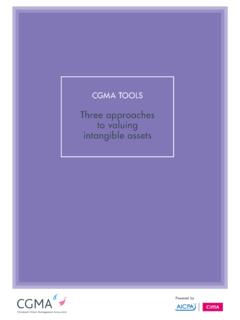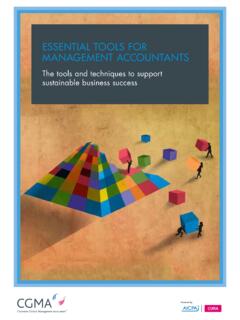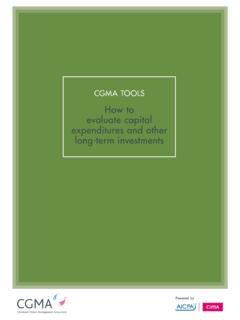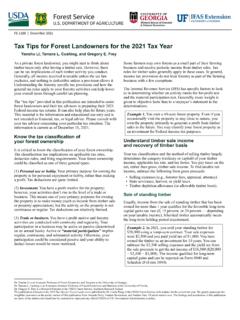Transcription of Six rules - Chartered Global Management Accountant
1 CGMA Research Brief Six rulesto delivering a powerful financial presentationChartered Global Management Accountant (CGMA ) CGMA is the most widely held Management accounting designation in the world. It distinguishes more than 150,000 accounting and finance professionals who have advanced proficiency in finance, operations, strategy and Management . In the , the vast majority are also CPAs. The CGMA designation is underpinned by extensive Global research to maintain the highest relevance with employers and develop competencies most in demand. CGMAs qualify through rigorous education, exam and experience requirements. They must commit to lifelong education and adhere to a stringent code of ethical conduct. Businesses, governments and nonprofits around the world trust CGMAs to guide critical decisions that drive strong performance.
2 AuthorsWe would like to thank Peter A. Margaritis, CPA, CGMA, and Jennifer H. Elder, CPA/CFF, CMA, CIA, CGMA, who contributed their time, knowledge, insight and experience to develop this CGMA A. Margaritis, CPA, CGMA, is an author, blogger, speaker, educator, humorist and podcaster. Partnering with the Business Learning Institute, his firm helps accountants and other business leaders to increase their profitability by strengthening their business success skills and improving morale through better communication. He is a member of the American Institute of CPAs, georgia Society of CPAs, Maryland Association of CPAs, Ohio Society of CPAs and the National Speakers Association. Peter is the author of Improv Is No Joke: Using Improvisation to Create Positive Results in Leadership and Life.
3 H. Elder, CPA/CFF, CMA, CIA, CGMA, is a speaker, author and executive coach. Her business, The Sustainable CFO, helps executives create long-term success in the future by developing proactive business strategies, professional communication skills and strong ethical values. She has been named A Woman to Watch by the Maryland Association of CPAs and Outstanding Educator by the Introduction4 First rule: It s all about the audience5 Second rule: Let go of the need for perfection6 Third rule: Grab the audience s attention6 Fourth rule: Tell the story behind the numbers7 Fifth rule: Use pictures to enhance the data8 Sixth rule: Simplify 10 Conclusion11 Endnotes11 Further readingContents 2 IntroductionWhen delivering a presentation, are you able to keep the audience engaged and awake?
4 Are you (and your presentation) interesting enough to keep them from looking at their mobile devices? Or is there a danger of being heckled? Bear in mind that heckling can come in many forms someone falling asleep is just as much heckling as somebody interrupting you. Do you have a fear of standing in front of an audience and delivering a presentation? Do you worry that you won t be seen as a subject-matter expert? 3 Many people have a fear of public speaking. As Jerry Seinfeld said: .. speaking in front of a crowd is considered the number one fear of the average person. A Forbes survey produced a list of the top nine fears:1. Public speaking 2. Crowds 3. Bridges 4. Enclosed spaces 5. Storms 6. Public transportation 7. Water 8. Heights 9.
5 Creatures (snakes, insects and rodents)Public speaking was the No. 1 fear, yet the other eight are things that actually could do you harm. Despite the way many speakers might feel, no one has died from public best way to overcome the fear of public speaking is through preparation. The better you prepare, the more confident you will be in delivering your presentation. You want to be prepared in such a way that you feel you re having a conversation with the audience, rather than sounding like a robot giving a memorised presentation. Presentations can be boring. Financial presentations are especially prone to being dull, particularly when someone rattles off figure after figure after figure. Think back to your school days: Did you ever have a teacher who read from slides, spoke monotonously and put you to sleep in the first five minutes?
6 If you have seen the movie Ferris Bueller s Day Off, you probably remember the scene where Ben Stein plays the teacher giving a boring lecture on history and none of the students are paying attention. He asks a question. No one answers, so he says, anyone, anyone? and keeps on going. Remember the looks on the students faces? Are you in danger of getting the same looks? If you want to engage your audience, present financial information with impact and give an altogether great presentation, you ll need to follow these six rules :1. It s all about the audience. 2. Let go of the need for perfection. 3. Grab the audience s attention. 4. Tell the story behind the numbers. 5. Use pictures to enhance the data. 6. people will say, Practice until you get it right.
7 With presentations, practice until you can t get it wrong. 4 First rule: It s all about the audienceDo you know your audience? Are they accounting, finance and analytical types? Or are they sales and marketing individuals? Or are they a mixture of both? Let s begin this discussion with a look at the brain. A brain has two hemispheres, left and right. The left hemisphere is responsible for language, logic and analytical thinking. That s the side that drives the accounting and finance people. The right hemisphere is responsible for holistic thought, intuition and creativity. It likes the big picture, not the detail. That s the side favoured by the sales and marketing people. Why is this important? Because when you re delivering financial information to holistic thinkers, their tendency is to avoid detail in numbers.
8 For them, focusing on the trees makes it hard to see the big picture of the if your audience is made up of a lot of left-hemisphere individuals, they would like to tell you: Don t overwhelm me with too much information at once. In other words, don t give them too much detail at a rapid-fire pace. That s because even an audience that loves numbers needs time to sift through the data and process what s being said. Ten bullet points on a PowerPoint slide delivered at the same time would be an excellent example of this. PowerPoint doesn t charge on a per slide basis, so use as many as it takes. A treasurer of a not-for-profit organisation used to give a monthly report to the board. Every month she had the same experience no one paid any attention to her presentation or any of her carefully crafted recommendations.
9 She said, I am so frustrated. They ignored almost all of my presentation. She felt she was wasting her time and was about to resign. She was attending a bored meeting, not a board meeting. We asked her to think about the audience and what was most important to them. She thought about it and said, Well, the one time they pay attention is at the end when I tell them the cash balance. We suggested she start her presentation with the cash balance and see what happens. She called us immediately after the next board meeting to say, The change was incredible. They paid attention to my entire presentation for the first time. They even voted to implement all of my recommendations! The point here is that if you deliver a presentation that s full of data and numbers, most of your audience will be doing the smartphone prayer.
10 They will be looking at their email or playing Angry Birds doing anything and everything except paying attention to you. This is the biggest challenge for accounting and finance presentations. How can you share the necessary information but not overwhelm and confuse the audience? To present financial information effectively and powerfully, you have to know your audience. Give them what they want to know about first. Once you have their attention, you can cover what they need to know s consider a current example of where less is moreHave you ever watched a TED (Technology, Entertainment and Design) talk? The first TED conference started in 1984, and according to : TED talks today cover almost all topics from science to business to Global issues in more than 100 languages.















